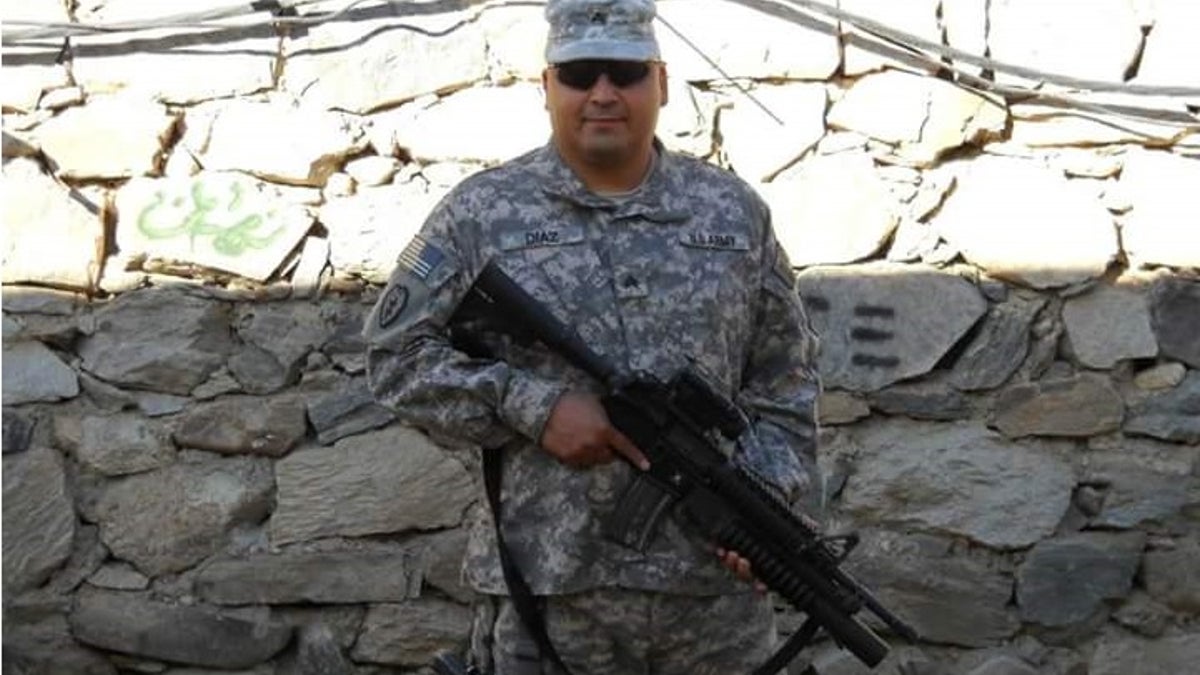
February 4, 2013: U.S. Army soldiers watch garbage burn in a burn-pit at Forward Operating Base Azzizulah in the Kandahar Province of Afghanistan.
Thousands of U.S. military personnel who served on bases in Iraq and Afghanistan recall the dense black smoke from burn pits where everything from IEDs to human waste was incinerated.
Now many have died, and more are gravely ill. Those battling a grim menu of cancers, as well as their loved ones and advocates, trace their condition to breathing in the toxic fumes they say could be the most recent wars' version of Agent Orange or Gulf War Illness.
“The clouds of smoke would just hang throughout the base,” Army Sgt. Daniel Diaz, who was stationed at Joint Base Balad, in Iraq's Sunni Triangle from 2004-2005, told FoxNews.com. “No one ever gave it any thought. You are just so focused on the mission at hand. In my mind, I was just getting ready for the fight.”
Diaz returned from duty in 2008. A year later, he started developing health problems including cancer, chronic fatigue and weakness, neuropathy and hypothyroidism. Nearly every base he was stationed at during his four tours in Iraq and Afghanistan had burn pits nearby - and pungent smoke everywhere.
“It’s breaking my family. I’m just trying to fight to stay alive long enough get my claim settled so my family has something when I am gone.”
“When I was stationed at Camp Wright, there was one 20-30 feet from our rooms,” he says. “No one ever questioned whether it was dangerous having it so close. Not even once.”
During the wars in both Iraq and Afghanistan, the burn pit method was adopted originally as a temporary measure to get rid of waste and garbage generated on bases. Everything was incinerated in the pits, say soldiers, including plastics, batteries, appliances, medicine, dead animals and even human waste. The items were often set ablaze with jet fuel as the accelerant.
Joint Base Balad, where Diaz was partially stationed, burned up to 147 tons of waste per day as recently as the summer of 2008, according to The Army Times.
The incineration of the waste generated numerous pollutants including carbon monoxide and dioxide—the same chemical compound found in Agent Orange, which left many Vietnam vets sick after it was used as a defoliant.
“It’s killing soldiers at a much higher rate than Agent Orange did in the Vietnam Era,” Rosie Torres, founder of Burn Pits 360, an advocacy group for service members who have fallen ill, told FoxNews.com. “Soldiers from that war were seen dying in their 50’s, 60’s or 70’s. Now with the soldiers returning from Iraq and Afghanistan, we are seeing them die in their early 20’s, 30’s, and 40’s.”

Sgt. Daniel Diaz was stationed near burn pits at Joint Base Balad in Iraq and now is bed ridden from multiple illnesses including various forms of aggressive cancer.
Torres, whose husband, LeRoy Torres, fell ill almost immediately after his return from Iraq in 2008, said nearly 64,000 active service members and retirees have put their names on the Burn Pit Registry created by the Department of Veterans Affairs.
But documenting their plight doesn't guarantee coverage.
“I haven’t got diddly squat," Diaz tells Foxnews.com. “The VA is refusing to admit that my cancers are service-related. It’s frustrating. I have $100,000 in medical bills because I have no coverage.
“It’s breaking my family," he said. "I’m just trying to fight to stay alive long enough get my claim settled so my family has something when I am gone.”
Once dead, servicemembers cannot retroactively be placed on the list, which advocates say leaves family members of the fallen in the lurch and often bankrupt.
“It’s a failed registry. It doesn’t work. It could take 20-30 years for someone to get assistance,” Joseph Hickman, author of the 2016 book “The Burn Pits: the Poisoning of America’s Soldiers,” told Foxnews.com. “It’s not fair. They need help now.”
The pits burned more than 1,000 different chemical compounds day and night, and most service members breathed in toxic fumes with no protection, said Hickman, who added the Agent Orange comparison is apt.

Christie Badstibner (r.), with husband Brian (l.,inset), a 14-year Air Force veteran who recently died.
“The Department of Defense won’t admit that this is occurring and the VA does not do enough to assist service members because they are waiting on info from the DoD,” he said.
Requests for comment from the Department of Defense were not immediately returned.
Not every case of cancer involving a service member can be blamed on burn pit exposure, but for families who have watched healthy loved ones succumb to terminal illness within months or a few years of returning home, the connection seems clear.
"It’s hard to believe that my husband did not get cancer from this," Christie Badstibner, whose husband Brian, a 14-year Air Force veteran who died two months ago, told FoxNews.com. “How can they deny that the pits had something to do with this? No one wants to take the blame.”
Badstibner, 36, says that because her husband was still on active duty when he returned, their family had health coverage and benefits. But she knows many other families who have suffered the same loss as hers, and been left with no coverage.
“There are a lot of families going through the same thing without any sort of coverage," she said. "There are widows like me, raising their kids on their own. It sucks.”

